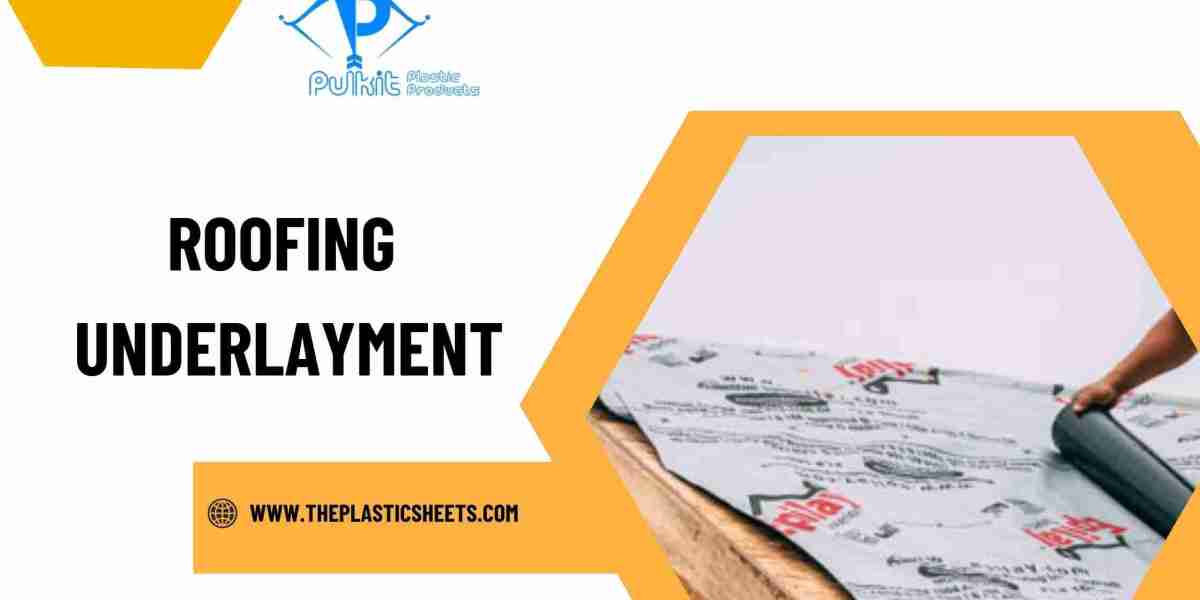When it comes to building a long-lasting and leak-resistant roofing system, the visible roofing material—like shingles or metal sheets—is only part of the story. Hidden beneath that exterior is an unsung hero: roofing underlayment. This protective layer plays a vital role in keeping your roof—and the home beneath it—safe from water damage, extreme temperatures, and wind uplift.
In this comprehensive guide, we’ll walk you through the types of roofing underlayment, their benefits, expert installation tips, and answer common questions. We’ll also discuss the use of roof underlayment for metal roofs, the best roofing underlayment options, and highlight trusted roof underlayments in India, including products from Pulkit Plastic Products, a notable name in the industry.
What Is Roofing Underlayment?
Roofing underlayment is a water-resistant or waterproof barrier installed directly onto the roof deck, underneath the primary roofing material. It acts as a secondary protection layer against rain, snow, and ice, especially during heavy storms or when shingles are damaged or dislodged.
Underlayments are particularly essential in regions that experience heavy rainfall, extreme temperatures, or high winds.
Types of Roofing Underlayment
Choosing the right type of underlayment depends on your climate, roofing material, budget, and project requirements. Let’s explore the three most common types:
1. Asphalt-Saturated Felt (Tar Paper)
Traditionally known as felt paper, this is one of the oldest types of underlayment. It’s made of organic or fiberglass substrates soaked in asphalt.
Pros:
Cost-effective
Good water resistance
Breathable to some extent
Cons:
Heavier and more prone to tearing
Shorter lifespan compared to synthetic options
2. Synthetic Underlayment
This modern, polymer-based product has quickly become the Best roofing underlayment option for many contractors. It is made from polypropylene or polyethylene and is more lightweight, durable, and tear-resistant than felt.
Pros:
Excellent strength and durability
UV-resistant and slip-resistant surface
Easy to install and lightweight
Cons:
More expensive than felt
Not all synthetics are created equal — quality varies
3. Rubberized Asphalt (Self-Adhering Membrane)
Ideal for areas prone to ice dams and water accumulation, this type of underlayment comes with a self-adhesive backing and a rubberized surface.
Pros:
Superior waterproofing
Ideal for valleys and roof edges
Great choice for low-slope roofs
Cons:
Higher cost
Requires clean, dry surfaces for proper adhesion
Roof Underlayment for Metal Roofs
Metal roofs are growing in popularity for their longevity, energy efficiency, and sleek appearance. However, they also require a high-performing underlayment system due to the way metal expands and contracts with temperature fluctuations.
For Roof underlayment for metal roofs, synthetic and rubberized asphalt are the top choices. These materials provide excellent heat resistance, waterproofing, and thermal stability. Rubberized underlayment is especially effective in preventing moisture buildup caused by condensation under metal sheets.
Pulkit Plastic Products, a leading manufacturer of roof underlayments in India, offers specialized underlayment materials that pair perfectly with metal roofing systems, ensuring long-term performance and protection.
Key Benefits of Roofing Underlayment
1. Water Resistance
Underlayment acts as a backup waterproof barrier, keeping moisture from penetrating the roof deck and causing rot, mold, or leaks.
2. Weather Protection During Construction
If roofing shingles haven’t been installed yet, the underlayment still provides temporary protection from rain and wind.
3. Enhanced Fire and UV Resistance
Some synthetic underlayments are fire-rated and UV-resistant, helping the structure withstand environmental stress.
4. Improved Roof Longevity
By providing a consistent barrier against water and air infiltration, underlayment extends the life of both the roof structure and the roofing material.
5. Smoother Installation
Many modern underlayments offer anti-slip surfaces and are lightweight, making them safer and easier to install.
Installation Tips for Roofing Underlayment
To get the most out of your roofing underlayment, consider the following expert tips:
1. Choose the Right Type
Base your selection on the roofing material, local climate, and slope of the roof. Metal roofs, for example, benefit more from synthetic or rubberized underlayments.
2. Prepare the Roof Deck
Ensure the roof deck is clean, dry, and free of any debris before applying the underlayment. This helps prevent bubbling or adhesive failure.
3. Overlap Correctly
For water to flow properly and not seep in, install each layer of underlayment with proper overlapping—usually 2 to 4 inches depending on the slope.
4. Use Cap Nails or Staples Appropriately
Synthetic underlayments often require specific types of fasteners. Follow manufacturer guidelines to ensure maximum hold and weatherproofing.
5. Focus on Valleys and Eaves
These are the most vulnerable areas of a roof. Use high-quality self-adhering underlayments in valleys, ridges, and eaves for additional protection.
Roofing Underlayments in India
The roofing industry in India is rapidly evolving, with increasing demand for high-quality, durable underlayment materials. From urban high-rises to industrial warehouses and residential homes, the need for dependable roofing systems is greater than ever.
Companies like Pulkit Plastic Products are at the forefront of providing top-tier Roof underlayments in India, known for their innovative product design, durability, and value-for-money offerings. They manufacture both synthetic and specialty underlayments that cater to diverse roofing needs across the country.
Conclusion
Roofing underlayment might be hidden from view, but its importance is anything but invisible. Whether you’re building a new structure or replacing an old roof, choosing the right underlayment is crucial for long-term performance and weather protection.
From traditional felt to advanced synthetics and rubberized asphalt, there’s an underlayment for every roofing need. If you're working with metal roofing systems, opting for the right roof underlayment for metal roofs is especially important.
By partnering with reliable suppliers like Pulkit Plastic Products, you can ensure you're getting the best roofing underlayment backed by quality assurance and product innovation.
Frequently Asked Questions (FAQs)
Q1: Is roofing underlayment necessary for all roofs?
Yes, roofing underlayment provides essential protection against water infiltration and helps maintain structural integrity, regardless of the outer roofing material.
Q2: What is the best roofing underlayment for hot climates?
In hot climates, synthetic underlayment with UV protection and heat resistance is considered the best choice.
Q3: Can I install underlayment myself?
While it is possible for skilled DIYers, it’s recommended to hire a professional to ensure correct installation, especially for complex roofs or metal roofing systems.








